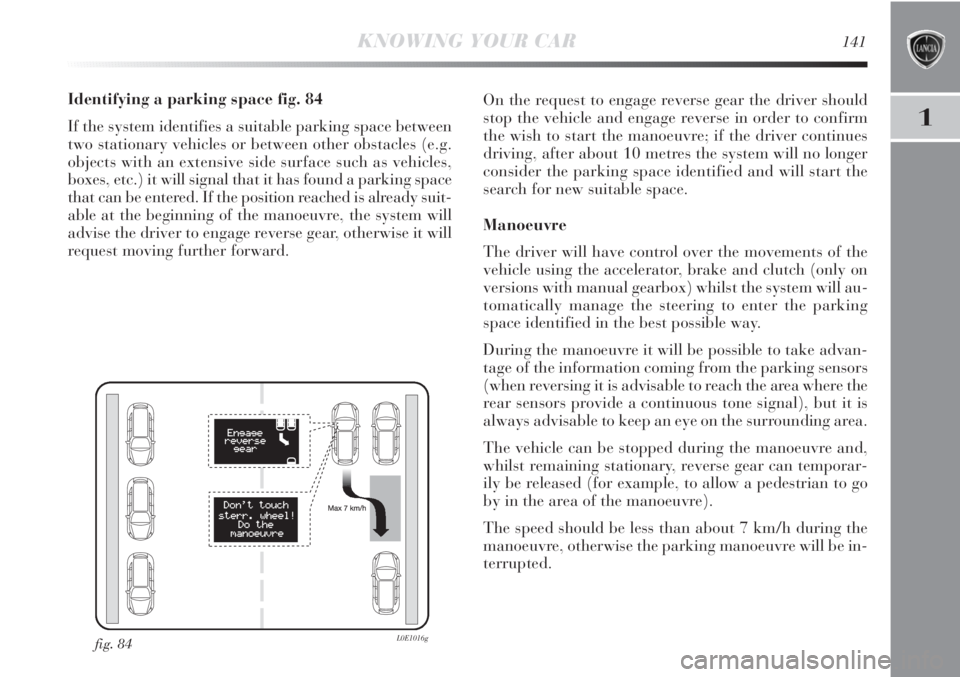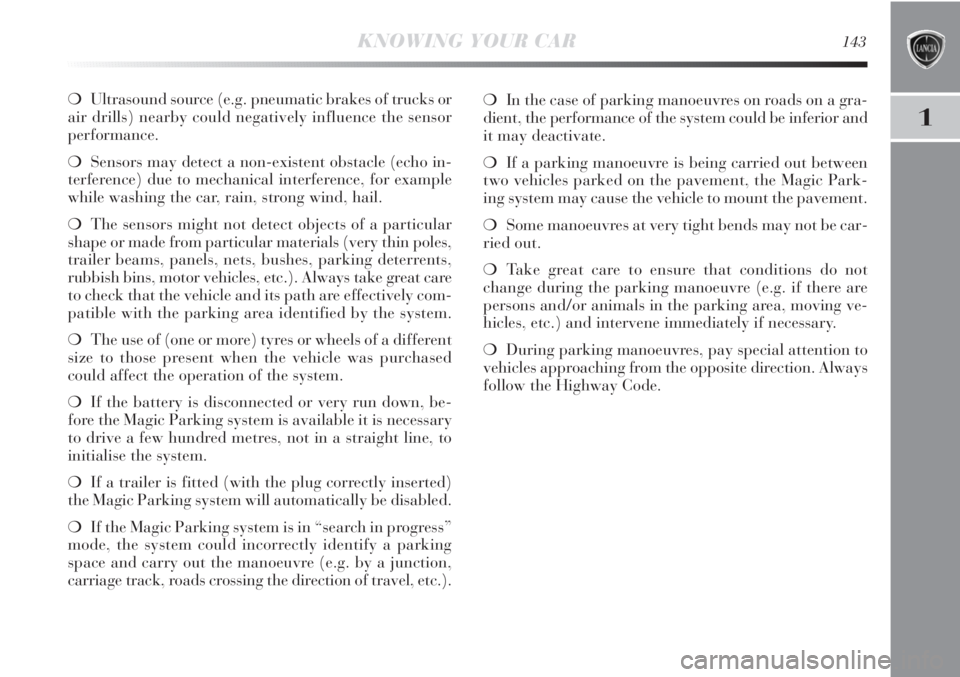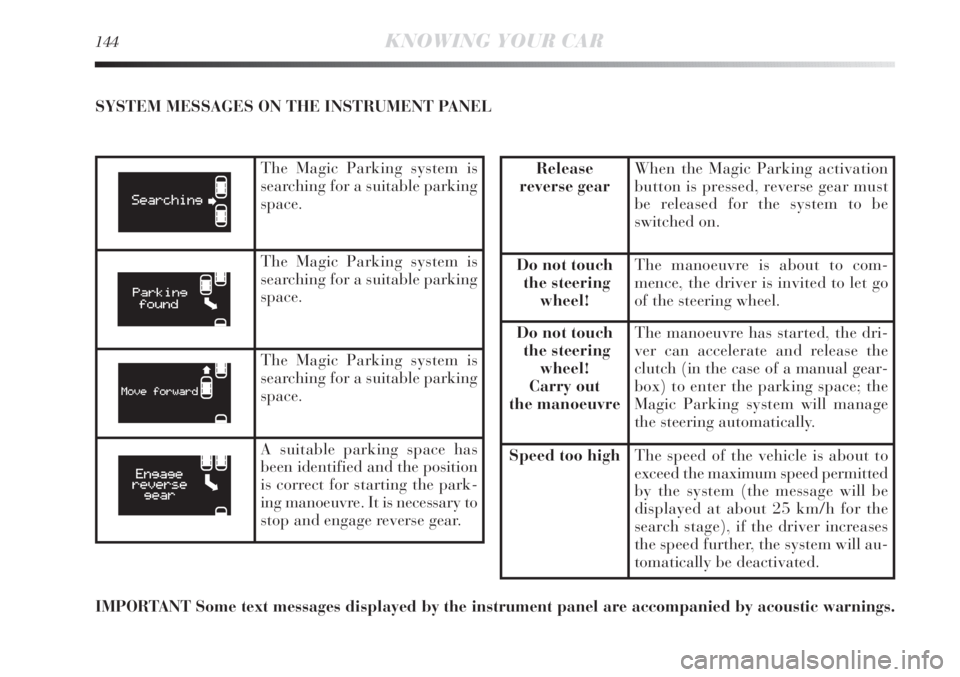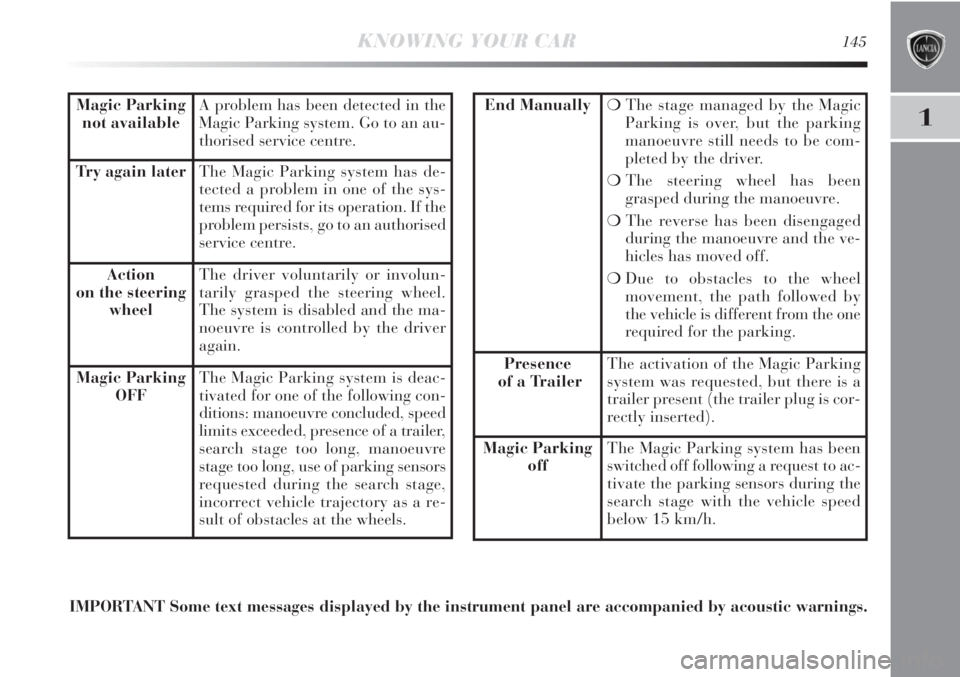Lancia Delta 2013 Owner handbook (in English)
Manufacturer: LANCIA, Model Year: 2013, Model line: Delta, Model: Lancia Delta 2013Pages: 295, PDF Size: 8.29 MB
Page 141 of 295

1
KNOWING YOUR CAR139
DESCRIPTION OF MANOEUVRING STAGES
Activation
The system is activated by pressing the button fig. 82 and,
as soon as it is activated, the system starts the search
stage. The LED in the button coming on indicates that the
system is activated. Since the system recognises parking
spaces even when it is deactivated, the system can be ac-
tivated straight away after having driven past an adjacent
parking space that is deemed suitable. If the system has
effectively identified a parking space, the search stage will
not be performed and the system will notify the driver of
the operations required to carry out the manoeuvre.Search for a parking place
During the search stage fig. 83 the vehicle should continue
following its route at a speed of below around 30 km/h
and at a distance of around 50 cm to 130 cm from parked
cars. A parking space is considered suitable if it is about
130 cm longer than the dimensions of the vehicle.
There are two possible types of parking:
❍parking space longer than 160 cm compared to the
vehicle dimensions:parking in a single manoeuvre
fig. 83L0E1015g
Page 142 of 295

140KNOWING YOUR CAR
❍parking space longer than 130 cm compared to the
vehicle dimensions:parking in more than one manoeu-
vre, where only the first one can be carried out by auto-
matic steering management (the subsequent manoeuvres
are entirely the responsibility of the driver).
To select the search and manoeuvring side, the driver
must:
1)
DChoose to carry out the search for the space and the
manoeuvre on the passenger side with:
❍the direction indicator in the middle position;
❍the hazard warning lights on;
❍the hazard warning lights on and the direction indi-
cator in the passenger side position;
❍the direction indicator pointing towards the passen-
ger side.
2)
FChoose to carry out the search for the space and the
manoeuvre on the driver’s side with:
❍the direction indicator in the driver’s side position;
❍the hazard warning lights on and the direction indi-
cator in the driver side position;
The system will notify the driver, on the side in which the
search and the manoeuvre are taking place by means of
dedicated messages in the instrument panel display and
the symbol (
Fand
D) different on the right and left sides. The search will, however, take place on both sides, there-
fore it is possible to make the selection using the direc-
tion indicators even when having just driven past a park-
ing space that is deemed suitable.
During the search step, speed should not exceed 30 km/h;
when 25 km/h have been reached, the driver is asked to
decrease the speed; if the speed of 30 km/h is exceeded,
the system is disabled; in this case, the system must be
restarted by pressing the button A-fig. 82.
If the Lane crossing function is activated (see “Exterior
lights” paragraph) the search for the parking space al-
ways takes place on the passenger side.
If the parking sensors are activated during the search for
a parking space (see “Front and rear parking sensors”
paragraph), the operation of the Magic Parking system is
deactivated.
The search for the parking space and the
parking manoeuvres must be made in com-
pliance with the regulations in force of the
Highway Code.
Page 143 of 295

1
KNOWING YOUR CAR141
Identifying a parking space fig. 84
If the system identifies a suitable parking space between
two stationary vehicles or between other obstacles (e.g.
objects with an extensive side surface such as vehicles,
boxes, etc.) it will signal that it has found a parking space
that can be entered. If the position reached is already suit-
able at the beginning of the manoeuvre, the system will
advise the driver to engage reverse gear, otherwise it will
request moving further forward.On the request to engage reverse gear the driver should
stop the vehicle and engage reverse in order to confirm
the wish to start the manoeuvre; if the driver continues
driving, after about 10 metres the system will no longer
consider the parking space identified and will start the
search for new suitable space.
Manoeuvre
The driver will have control over the movements of the
vehicle using the accelerator, brake and clutch (only on
versions with manual gearbox) whilst the system will au-
tomatically manage the steering to enter the parking
space identified in the best possible way.
During the manoeuvre it will be possible to take advan-
tage of the information coming from the parking sensors
(when reversing it is advisable to reach the area where the
rear sensors provide a continuous tone signal), but it is
always advisable to keep an eye on the surrounding area.
The vehicle can be stopped during the manoeuvre and,
whilst remaining stationary, reverse gear can temporar-
ily be released (for example, to allow a pedestrian to go
by in the area of the manoeuvre).
The speed should be less than about 7 km/h during the
manoeuvre, otherwise the parking manoeuvre will be in-
terrupted.
fig. 84L0E1016g
Page 144 of 295

142KNOWING YOUR CAR
If the driver carries out a voluntary or involuntary action
on the steering during the parking manoeuvre (touch-
ing it or preventing its movement), the manoeuvre will
be interrupted.
If the road surface is very uneven or there are obstacles
under the wheels affecting the movement of the vehicle,
preventing it from continuing along the correct trajectory,
the manoeuvre may be interrupted.
Manoeuvre end
If the size of parking space permits, the parking ma-
noeuvre may be performed in one go; when reverse gear
is released the wheels will be realigned and the manoeu-
vre will be considered completed; the system will conse-
quently be deactivated. If the size of the parking space is
smaller, it may take several manoeuvres, the driver will
be advised to complete the parking manoeuvre manually
via a dedicated messages in the instrument panel display.General warnings
❍The ultimate responsibility when parking, however,
always rests with the driver. During these manoeuvres,
always make sure that no people, animals or objects are
within the manoeuvring area. The Magic Parking sys-
tem (like parking sensors) is designed to assist drivers: in
all cases, you must always pay the utmost attention dur-
ing potentially dangerous manoeuvres, even when these
are carried out a low speed:
❍If the sensors undergo shocks influencing their posi-
tion, the system operation could be strongly degraded.
❍If the sensors are dirty, covered by snow, ice or mud
or are repainted compared to the original conditions, the
system operation could be strongly degraded.
❍It is extremely important, for the correct operation of
the system, that the sensors are always kept clean. Dur-
ing cleaning make sure not to scratch or damage them;
avoid using dry or rough cloths. The sensors should be
washed using clean water with the addition of car sham-
poo if necessary. When using special washing equipment
such as high pressure jets or steam cleaning, clean the
sensors very quickly keeping the jet more than 10 cm
away.
If you wish to stop the steering wheel with
your hands during a manoeuvre, it is
advisable to handle it firmly on the outer
rim. Do not try and keep your hands on the inside
or hold the spokes.
Page 145 of 295

1
KNOWING YOUR CAR143
❍Ultrasound source (e.g. pneumatic brakes of trucks or
air drills) nearby could negatively influence the sensor
performance.
❍Sensors may detect a non-existent obstacle (echo in-
terference) due to mechanical interference, for example
while washing the car, rain, strong wind, hail.
❍The sensors might not detect objects of a particular
shape or made from particular materials (very thin poles,
trailer beams, panels, nets, bushes, parking deterrents,
rubbish bins, motor vehicles, etc.). Always take great care
to check that the vehicle and its path are effectively com-
patible with the parking area identified by the system.
❍The use of (one or more) tyres or wheels of a different
size to those present when the vehicle was purchased
could affect the operation of the system.
❍If the battery is disconnected or very run down, be-
fore the Magic Parking system is available it is necessary
to drive a few hundred metres, not in a straight line, to
initialise the system.
❍If a trailer is fitted (with the plug correctly inserted)
the Magic Parking system will automatically be disabled.
❍If the Magic Parking system is in “search in progress”
mode, the system could incorrectly identify a parking
space and carry out the manoeuvre (e.g. by a junction,
carriage track, roads crossing the direction of travel, etc.).❍In the case of parking manoeuvres on roads on a gra-
dient, the performance of the system could be inferior and
it may deactivate.
❍If a parking manoeuvre is being carried out between
two vehicles parked on the pavement, the Magic Park-
ing system may cause the vehicle to mount the pavement.
❍Some manoeuvres at very tight bends may not be car-
ried out.
❍Take great care to ensure that conditions do not
change during the parking manoeuvre (e.g. if there are
persons and/or animals in the parking area, moving ve-
hicles, etc.) and intervene immediately if necessary.
❍During parking manoeuvres, pay special attention to
vehicles approaching from the opposite direction. Always
follow the Highway Code.
Page 146 of 295

144KNOWING YOUR CAR
SYSTEM MESSAGES ON THE INSTRUMENT PANEL
The Magic Parking system is
searching for a suitable parking
space.
The Magic Parking system is
searching for a suitable parking
space.
The Magic Parking system is
searching for a suitable parking
space.
A suitable parking space has
been identified and the position
is correct for starting the park-
ing manoeuvre. It is necessary to
stop and engage reverse gear.
Release
reverse gearWhen the Magic Parking activation
button is pressed, reverse gear must
be released for the system to be
switched on.
Do not touch
the steering
wheel!The manoeuvre is about to com-
mence, the driver is invited to let go
of the steering wheel.
Do not touch
the steering
wheel!
Carry out
the manoeuvreThe manoeuvre has started, the dri-
ver can accelerate and release the
clutch (in the case of a manual gear-
box) to enter the parking space; the
Magic Parking system will manage
the steering automatically.
Speed too highThe speed of the vehicle is about to
exceed the maximum speed permitted
by the system (the message will be
displayed at about 25 km/h for the
search stage), if the driver increases
the speed further, the system will au-
tomatically be deactivated.
IMPORTANT Some text messages displayed by the instrument panel are accompanied by acoustic warnings.
Page 147 of 295

1
KNOWING YOUR CAR145
Magic Parking
not availableA problem has been detected in the
Magic Parking system. Go to an au-
thorised service centre.
Try again laterThe Magic Parking system has de-
tected a problem in one of the sys-
tems required for its operation. If the
problem persists, go to an authorised
service centre.
Action
on the steering
wheelThe driver voluntarily or involun-
tarily grasped the steering wheel.
The system is disabled and the ma-
noeuvre is controlled by the driver
again.
Magic Parking
OFFThe Magic Parking system is deac-
tivated for one of the following con-
ditions: manoeuvre concluded, speed
limits exceeded, presence of a trailer,
search stage too long, manoeuvre
stage too long, use of parking sensors
requested during the search stage,
incorrect vehicle trajectory as a re-
sult of obstacles at the wheels.
End Manually❍The stage managed by the Magic
Parking is over, but the parking
manoeuvre still needs to be com-
pleted by the driver.
❍The steering wheel has been
grasped during the manoeuvre.
❍The reverse has been disengaged
during the manoeuvre and the ve-
hicles has moved off.
❍Due to obstacles to the wheel
movement, the path followed by
the vehicle is different from the one
required for the parking.
Presence
of a TrailerThe activation of the Magic Parking
system was requested, but there is a
trailer present (the trailer plug is cor-
rectly inserted).
Magic Parking
offThe Magic Parking system has been
switched off following a request to ac-
tivate the parking sensors during the
search stage with the vehicle speed
below 15 km/h.
IMPORTANT Some text messages displayed by the instrument panel are accompanied by acoustic warnings.
Page 148 of 295

146KNOWING YOUR CAR
FRONT AND REAR PARKING SENSORS
(combined with Magic Parking)
(for versions/markets where provided)
The parking sensors provide the driver with distance in-
formation when approaching obstacles in front of and be-
hind the vehicle (versions with 4 front and 4 rear sensors)
always combined with the Magic Parking function. The
system therefore provides a further aid during parking
manoeuvres because it allows the identification of obsta-
cles outside of the driver’s field of vision. The driver is notified of the presence and distance of the
obstacle from the vehicle by an acoustic signal which
varies depending on the distance from the obstacle (as the
distance from the obstacle decreases the frequency of the
acoustic signal increases).
SENSORS
In order to measure the distance of obstacles, the system
uses 4 sensors located in the front bumper (where pro-
vided) fig. 85 and 4 sensors located in the rear bumper
fig. 86.
fig. 85L0E0059mfig. 86L0E0298m
Page 149 of 295

1
KNOWING YOUR CAR147
Version with 8 sensors
On the version with 4 front sensors and 4 rear sensors,
the system is activated when reverse gear is engaged or
by pressing the button fig. 87. If there has been a request
to activate the Magic Parking function, the front and rear
sensors are not automatically activated during the search
for a parking space, but can be activated by pressing the
special button (fig. 87) or by engaging reverse gear when
the speed is below around 15 km/h.
When reverse gear is released, the front and rear sensors
remain activated until a speed of around 15 km/h is ex-
ceeded to allow the parking manoeuvre to be completed.
The system can also be activated by pressing the button
fig. 87 in the central panel: a warning light in the but-
ton comes on when the system is activated.The sensors are deactivated by pressing the button again
fig. 87 or when a speed of 15 km/h is exceeded: the
warning light in the button is off when the system is not
active.
When the sensors are activated, the system starts to pro-
duce acoustic signals from the front or rear buzzers as
soon as an obstacle is detected with the frequency in-
creasing as the obstacle gets closer.
When the obstacle is less than about 30 cm away, the
sound becomes continuous. Depending on the position of
the obstacle (in front or behind) the sound is produced
by the corresponding buzzers (front or rear). The obsta-
cle closest to the vehicle is signalled.
The acoustic signal stops immediately if the distance of
the obstacle increases. The sound cycle remains constant
if the distance measured by the centre sensors remains
unchanged, whilst if this situation occurs for the side sen-
sors, the signal is interrupted after about 3 seconds (for
example, to prevent signals in the case of manoeuvres
alongside walls).
fig. 87L0E0249m
The responsibility for parking and other
dangerous manoeuvres always and in every
case lies with the driver. While manoeu-
vring, always make sure that no-one is in the area
concerned (especially children) or animals. The
parking sensors are designed to assist drivers: in
any case, you must always pay the utmost atten-
tion during potentially dangerous manoeuvres,
even when carried out at low speed.
Page 150 of 295

148KNOWING YOUR CAR
ACOUSTIC SIGNAL
The information concerning the presence and distance of
an obstacle from the vehicle is transmitted by means of
acoustic signals from 2 buzzers installed in the passenger
compartment:
❍a front buzzer warns of the presence of obstacles at
the front and a buzzer located at the rear warns of the
presence of obstacles at the rear. This notifies the driver
of the direction (front/rear) of the obstacles.
Operation is automatically activated when reverse gear
is engaged.
The acoustic signal:
❍increases as the distance between the car and the ob-
stacle decreases;
❍becomes continuous when the distance between the
car and the obstacle is less than around 30 cm and stops
immediately if the distance increases;
❍is constant if the distance is unvaried; if this situa-
tion occurs for the side sensors, the indication will stop
after about 3 seconds to avoid, for example, warning in-
dications in the event of manoeuvres alongside walls.The sensor must be clean of mud, dirt, snow
or ice in order for the system to operate cor-
rectly. Be careful not to scratch or damage the
sensors while cleaning them. Avoid using dry, rough
or hard cloths. The sensors should be washed using
clean water with the addition of car shampoo if nec-
essary. When using special washing equipment such
as high pressure jets or steam cleaning, clean the
sensors very quickly keeping the jet more than
10 cm away.
Only have the bumpers repainted or any re-
touches to the paintwork in the area of the
sensors carried out by a Lancia Dealership.
If the paint is incorrectly applied this could ad-
versely affect the operation of the parking sensors.
SENSOR OPERATING RANGE
The sensors allow the system to check the front part (ver-
sion with 8 sensors) and rear part of the vehicle.
Their position covers the middle and side areas of the
front and rear of the vehicle. If an obstacle is located in
a middle area, it is detected when the distance is less than
about 0.9 m (front) and 1.30 m (rear).
If the obstacle is located at the side, it is detected at dis-
tances of less than 0.6 m.